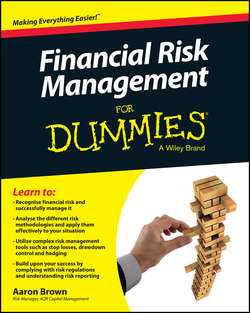Читать книгу Financial Risk Management For Dummies - Aaron Brown - Страница 7
На сайте Литреса книга снята с продажи.
Part I
Getting Started with Risk Management
Chapter 1
Living with Risk
Communicating Risk
ОглавлениеI’m often asked what the most important job of a risk manager is. The answer is simple but unexpected to most people: The risk manager’s most crucial task is to communicate a single vision of risk to all stakeholders: equity holders, creditors, customers, executives, regulators, employees, trading counterparties – everyone. It’s nice if that single vision happens to be accurate, but unfortunately you can only do your best in that respect. What you can promise is that the vision is the same for everyone.
Note that I don’t say that the risk manager convinces everyone of the same vision of risk. People will always disagree about what the risk is. What they should not disagree about is what vision of risk is driving firm decisions.
Suppose that an entrepreneur lays out a proposed project. A lot of people take a look, and most have no interest. But some people are optimistic enough to lend money for the venture. Others are even more optimistic and are willing to put money in for a share of any profits after the lenders are paid. Some people want to work in the project for salary, or for equity options. Some people want to sign up to be suppliers to the project, or customers of it. The government probably gets into the act with various regulatory and tax interests. These people disagree by necessity; otherwise they would all be vying for the same role.
How do you keep the process honest? That is, how do you prevent the entrepreneur from telling creditors that the project will be run for maximum safety of repayment, telling the equity buyers that the project will be run for maximum upside, and the government that it will be run for social benefit? How do you prevent the owner from promising the same money to employees, suppliers and customers?
If you knew exactly how the project would turn out, an accountant could audit the projected books to make sure that each dollar went to exactly one place. However, given that many future scenarios are possible, that solution isn’t practical. Instead of an accountant, you need a risk manager to lay out the range of possible futures in a form that balances simplicity (so stakeholders can understand it) with detail (so it captures the important contingencies and decisions). Each stakeholder makes an informed decision to participate based on a consistent promise of how the project will be run.
Of course, the actual outcome of the project will differ from all the risk manager’s projections, perhaps in crucial ways. Some stakeholders may prosper while others suffer. After the fact, it’s impossible to say whether the outcomes were fair or not. However, as long as everyone had the same risk information going in and as long as the project was run consistent with the promises made, then the responsibility for any gain or loss rests with the stakeholders’ choices, and is fair in that sense. (I talk about communication in Chapter 18.)
This isn’t to say that communication is the only duty of a financial risk manager. You can do things to make risk taking more productive and successful. You can encourage good risk (innovation, opportunity, experimentation, creativity, attractive bets) and discourage bad risk (carelessness, recklessness, unnecessary danger, chasing unattractive bets). You can build a positive risk culture, and gain consensus behind a shrewd risk strategy. But consistent risk communication is job one.
